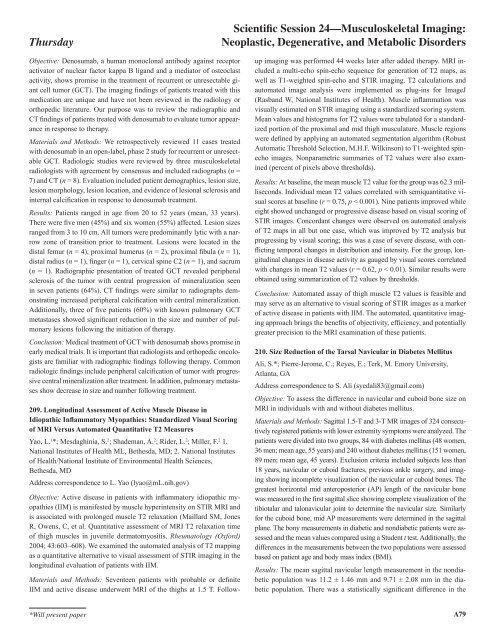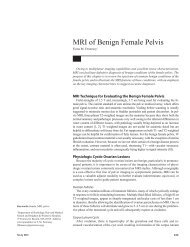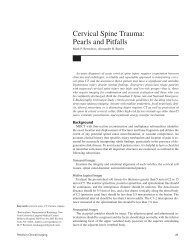Scientific Session 1 â Breast Imaging: Mammography
Scientific Session 1 â Breast Imaging: Mammography
Scientific Session 1 â Breast Imaging: Mammography
You also want an ePaper? Increase the reach of your titles
YUMPU automatically turns print PDFs into web optimized ePapers that Google loves.
Thursday<strong>Scientific</strong> <strong>Session</strong> 24—Musculoskeletal <strong>Imaging</strong>:Neoplastic, Degenerative, and Metabolic DisordersObjective: Denosumab, a human monoclonal antibody against receptoractivator of nuclear factor kappa B ligand and a mediator of osteoclastactivity, shows promise in the treatment of recurrent or unresectable giantcell tumor (GCT). The imaging findings of patients treated with thismedication are unique and have not been reviewed in the radiology ororthopedic literature. Our purpose was to review the radiographic andCT findings of patients treated with denosumab to evaluate tumor appearancein response to therapy.Materials and Methods: We retrospectively reviewed 11 cases treatedwith denosumab in an open-label, phase 2 study for recurrent or unresectableGCT. Radiologic studies were reviewed by three musculoskeletalradiologists with agreement by consensus and included radiographs (n =7) and CT (n = 8). Evaluation included patient demographics, lesion size,lesion morphology, lesion location, and evidence of lesional sclerosis andinternal calcification in response to denosumab treatment.Results: Patients ranged in age from 20 to 52 years (mean, 33 years).There were five men (45%) and six women (55%) affected. Lesion sizesranged from 3 to 10 cm. All tumors were predominantly lytic with a narrowzone of transition prior to treatment. Lesions were located in thedistal femur (n = 4), proximal humerus (n = 2), proximal fibula (n = 1),distal radius (n = 1), finger (n = 1), cervical spine C2 (n = 1), and sacrum(n = 1). Radiographic presentation of treated GCT revealed peripheralsclerosis of the tumor with central progression of mineralization seenin seven patients (64%). CT findings were similar to radiographs demonstratingincreased peripheral calcification with central mineralization.Additionally, three of five patients (60%) with known pulmonary GCTmetastases showed significant reduction in the size and number of pulmonarylesions following the initiation of therapy.Conclusion: Medical treatment of GCT with denosumab shows promise inearly medical trials. It is important that radiologists and orthopedic oncologistsare familiar with radiographic findings following therapy. Commonradiologic findings include peripheral calcification of tumor with progressivecentral mineralization after treatment. In addition, pulmonary metastasesshow decrease in size and number following treatment.209. Longitudinal Assessment of Active Muscle Disease inIdiopathic Inflammatory Myopathies: Standardized Visual Scoringof MRI Versus Automated Quantitative T2 MeasuresYao, L. 1 *; Mesdaghinia, S. 2 ; Shademan, A. 2 ; Rider, L. 2 ; Miller, F. 2 1.National Institutes of Health ML, Bethesda, MD; 2. National Institutesof Health/National Institute of Environmental Health Sciences,Bethesda, MDAddress correspondence to L. Yao (lyao@mL.nih.gov)Objective: Active disease in patients with inflammatory idiopathic myopathies(IIM) is manifested by muscle hyperintensity on STIR MRI andis associated with prolonged muscle T2 relaxation (Maillard SM, JonesR, Owens, C, et al. Quantitative assessment of MRI T2 relaxation timeof thigh muscles in juvenile dermatomyositis. Rheumatology (Oxford)2004; 43:603–608). We examined the automated analysis of T2 mappingas a quantitative alternative to visual assessment of STIR imaging in thelongitudinal evaluation of patients with IIM.Materials and Methods: Seventeen patients with probable or definiteIIM and active disease underwent MRI of the thighs at 1.5 T. Followupimaging was performed 44 weeks later after added therapy. MRI includeda multi-echo spin-echo sequence for generation of T2 maps, aswell as T1-weighted spin-echo and STIR imaging. T2 calculations andautomated image analysis were implemented as plug-ins for ImageJ(Rasband W, National Institutes of Health). Muscle inflammation wasvisually estimated on STIR imaging using a standardized scoring system.Mean values and histograms for T2 values were tabulated for a standardizedportion of the proximal and mid thigh musculature. Muscle regionswere defined by applying an automated segmentation algorithm (RobustAutomatic Threshold Selection, M.H.F. Wilkinson) to T1-weighted spinechoimages. Nonparametric summaries of T2 values were also examined(percent of pixels above thresholds).Results: At baseline, the mean muscle T2 value for the group was 62.3 milliseconds.Individual mean T2 values correlated with semiquantitative visualscores at baseline (r = 0.75, p < 0.001). Nine patients improved whileeight showed unchanged or progressive disease based on visual scoring ofSTIR images. Concordant changes were observed on automated analysisof T2 maps in all but one case, which was improved by T2 analysis butprogressing by visual scoring; this was a case of severe disease, with conflictingtemporal changes in distribution and intensity. For the group, longitudinalchanges in disease activity as gauged by visual scores correlatedwith changes in mean T2 values (r = 0.62, p < 0.01). Similar results wereobtained using summarization of T2 values by thresholds.Conclusion: Automated assay of thigh muscle T2 values is feasible andmay serve as an alternative to visual scoring of STIR images as a markerof active disease in patients with IIM. The automated, quantitative imagingapproach brings the benefits of objectivity, efficiency, and potentiallygreater precision to the MRI examination of these patients.210. Size Reduction of the Tarsal Navicular in Diabetes MellitusAli, S.*; Pierre-Jerome, C.; Reyes, E.; Terk, M. Emory University,Atlanta, GAAddress correspondence to S. Ali (syedali83@gmail.com)Objective: To assess the difference in navicular and cuboid bone size onMRI in individuals with and without diabetes mellitus.Materials and Methods: Sagittal 1.5-T and 3-T MR images of 324 consecutivelyregistered patients with lower extremity symptoms were analyzed. Thepatients were divided into two groups, 84 with diabetes mellitus (48 women,36 men; mean age, 55 years) and 240 without diabetes mellitus (151 women,89 men; mean age, 45 years). Exclusion criteria included subjects less than18 years, navicular or cuboid fractures, previous ankle surgery, and imagingshowing incomplete visualization of the navicular or cuboid bones. Thegreatest horizontal mid anteroposterior (AP) length of the navicular bonewas measured in the first sagittal slice showing complete visualization of thetibiotalar and talonavicular joint to determine the navicular size. Similarlyfor the cuboid bone, mid AP measurements were determined in the sagittalplane. The bony measurements in diabetic and nondiabetic patients were assessedand the mean values compared using a Student t test. Additionally, thedifferences in the measurements between the two populations were assessedbased on patient age and body mass index (BMI).Results: The mean sagittal navicular length measurement in the nondiabeticpopulation was 11.2 ± 1.46 mm and 9.71 ± 2.08 mm in the diabeticpopulation. There was a statistically significant difference in the*Will present paperA79
















